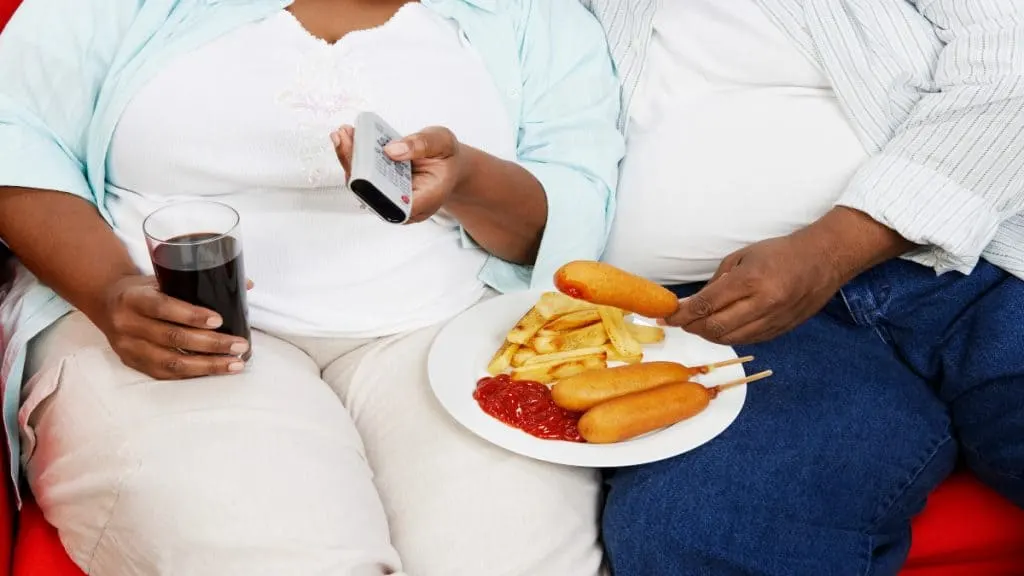A 59 inch waist is a very large waist size for women and men, so this article will give you some practical tips for losing abdominal fat and improving your fitness levels (no gym needed).
To get a detailed insight into other common waist sizes and learn how they affect your health and wellbeing, see the articles below.
- 50 inch waist
- 51 inch waist
- 52 inch waist
- 53 inch waist
- 54 inch waist
- 55 inch waist
- 56 inch waist
- 57 inch waist
- 58 inch waist
- 60 inch waist
How big is a 59 inch waist for males and females?

For both men and women, a 59 inch waist is too large for a person to live in good health. That’s because a 59″ waist is around 20 inches bigger than average and well above the cut-off points (37 inches for men, 35 inches for women) for being considered low-risk of chronic disease.
Research shows that having excess body weight during midlife can increase your risk of death. [1] As worrying as this is, carrying excess body fat can also make your everyday life less enjoyable because being abdominally obese can put pressure on your joints and make it difficult to find clothes that fit you well.
You definitely don’t want to wait around for your waist to get any bigger because, at some point, your stomach will be an obstruction to physical activity, which is one of the best ways to reduce your waist size and improve your cardiovascular fitness.
Is it possible to lose your 59 inch waist?

Yes, it’s definitely possible to lose your 59 inch waist and enjoy life in better health. But you need to be sensible and avoid letting your emotions get the better of you.
What I mean by that is that you shouldn’t panic too much when you realize that obesity is associated with higher incidences of cardiovascular disease and all-cause mortality [2] because panicking too much could cause you to make poor decisions.
For example, starving yourself in a bid to drop weight as quickly as possible is a bad idea because it’s an inherently unsustainable practice and one that would leave you with no energy to get up off the couch.
Instead, you should lower calories and slowly increase your energy expenditure to the point where you’re losing 1-2 pounds per week. For someone with a 59″ waist, this level of weight loss is sustainable.
What causes some individuals to have a 59 in waist?

Genetics, lack of physical activity, overconsumption, and readily available access to calorie-dense foods are all likely contributors toward someone having a 59 inch waistline.
For example, if you live in a big city, it’s likely that you don’t need to do as much walking as someone who lives in a rural area. Additionally, you have much easier access to convenient calorie-dense foods, which are addictive and commonly lead to weight gain when paired with a sedentary lifestyle.
Your genetics also play a role in how much fat you store and where you store it, but they’re not the sole cause of having a 59 in waist.
Try to identify the main culprits in your life and then eradicate them. If you’re too sedentary, try and commit to a half an hour walk every day. Walking burns significantly more calories than sitting down, and getting outside in the fresh air can really improve your mood as well.
On the other hand, perhaps you eat too much takeout food? If so, try cooking from scratch more often so that you can control the ingredients that go into your meals.
In conclusion

It’s commonly said that the best diet is the one that you can stick to, and I couldn’t agree more. [3]
Consistency trumps excellence when it comes to weight loss.
You might have heard of people losing an incredible amount of weight in a week or two, but it’s highly likely that many of these individuals balloon back to their previous state after realizing that their weight loss regime was unsustainable.
Let these examples be a lesson to you. You can’t expect to lose your 59 inch waist in a month when you didn’t build it in a month. Eat in a moderate calorie deficit (there are many apps that will track your calories and macros), progressively bump up your activity level, and reward yourself with enough restful sleep.
References
- Adams, K., Schatzkin, A., & Harris, T. (2006). Overweight, Obesity, And Mortality In A Large Prospective Cohort Of Persons 50 To 71 Years Old. Journal of Vascular Surgery, 44(6), 1374. https://doi.org/10.1016/j.jvs.2006.10.010
- Zhang, C., Rexrode, K. M., van Dam, R. M., Li, T. Y., & Hu, F. B. (2008). Abdominal Obesity and the Risk of All-Cause, Cardiovascular, and Cancer Mortality. Circulation, 117(13), 1658–1667. https://doi.org/10.1161/circulationaha.107.739714
- Carroll, A. E. (2018, March 26). What We Know (and Don’t Know) About How to Lose Weight. The New York Times. https://www.nytimes.com/2018/03/26/upshot/what-we-know-and-dont-know-about-how-to-lose-weight.html

